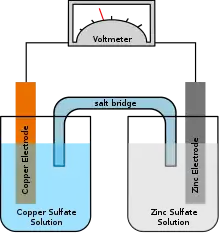Polysulfide bromide battery
The polysulfide bromide battery (PSB; sometimes polysulphide bromide), is a type of regenerative fuel cell involving a reversible electrochemical reaction between two salt-solution electrolytes: sodium bromide and sodium polysulfide. It is an example and type of redox (reduction–oxidation) flow battery.
In 2002, a 12 MWe prototype electrical storage facility was built at Little Barford Power Station in the UK,[1] which uses polysulfide bromide flow batteries. Although the facility was completed, due to engineering issues in scaling up the technology, it was never fully commissioned.[2] A similar demonstration plant located at the Tennessee Valley Authority (TVA) facility in Columbus, Mississippi, United States was never completed.
Chemistry
Two different salt solution electrolytes are contained in two separate tanks. When energy is required, a solution of Na2S2 (sodium disulfide) is pumped to the anode, and NaBr3 (sodium tribromide) is pumped to the cathode. The anode and cathode, and their corresponding salt solutions, are separated by an ion exchange membrane. At the negative electrode, the anodic reaction is shown as:
2Na2S2 → Na2S4 + 2Na+ + 2e−
At the positive electrode, the cathodic reaction is shown as:
NaBr3 + 2Na+ + 2e−→ 3NaBr
As energy is drawn from the system, the sodium disulfide becomes sodium polysulfide, and the sodium tribromide becomes sodium bromide. This reaction can be reversed when a current is supplied to the electrodes, and the system chemical salts are recharged. The system is defined as a fuel cell because the electrodes are not consumed by the reaction, they act only as a surface for the reaction. However, nor is the liquid a fuel that is consumed. It is a salt solution electrolyte that is changed by the process.
See also
References
- Price, A.; Bartley, S.; Cooley, G.; Male, S. (1999). "A novel approach to utility-scale energy storage". Power Engineering Journal. 13 (3): 122–129. doi:10.1049/pe:19990304.
- "Review of Electrical Energy Storage Technologies and Systems and of their Potential for the UK" (PDF). p. 24. Archived from the original (PDF) on 19 September 2010. Retrieved 24 November 2012.
